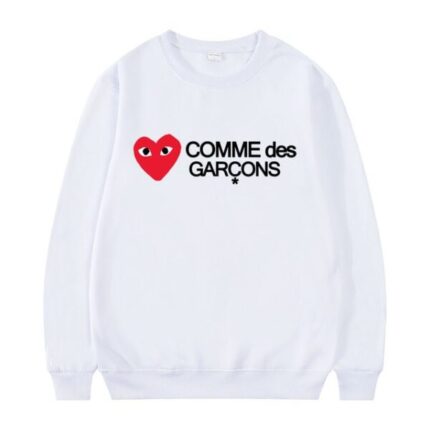
In the ever-evolving landscape of fashion, few names resonate with as much artistic rebellion and conceptual brilliance as Comme des Garçons. Founded in Tokyo in 1969 by Rei Kawakubo, the brand has long stood as a beacon of avant-garde experimentation. Far from Comme Des Garcons conforming to the cyclical nature of seasonal trends, Comme des Garçons has continually rewritten the rules of what fashion can and should be. Over more than five decades, the brand has become synonymous with intellectual design, anti-fashion aesthetics, and a relentless push against the boundaries of form, function, and beauty.
The Visionary Behind the Label
At the heart of Comme des Garçons lies the vision of Rei Kawakubo, a designer known for her refusal to adhere to conventional norms. Originally trained in fine arts and literature, Kawakubo transitioned to fashion not through formal education in design but through a personal, unfiltered vision of what clothing could express. Her label’s name, which translates from French to “like boys,” already hinted at the gender-fluid aesthetic and subversion of norms that would become a defining feature of the brand.
Kawakubo’s early collections challenged perceptions of femininity by rejecting the traditionally flattering silhouette. Instead, she embraced asymmetry, deconstruction, and unconventional materials. From the very beginning, her work was more about concept and message than commercial viability. This approach earned her a cult following in Japan and, eventually, global recognition.
A Radical Entrance to Paris
Comme des Garçons’ international breakthrough came in 1981 when Kawakubo presented her first runway show in Paris. The collection, dominated by black, draped fabrics and distressed textures, was a direct departure from the bright, opulent styles popular in the early 1980s. Critics labeled it as “Hiroshima chic,” and many were baffled by its austerity and abstraction. But among fashion’s forward-thinkers, the show was recognized as a paradigm shift.
The 1981 show, and many that followed, challenged Western fashion norms with a distinctly Japanese perspective on beauty and form. Kawakubo’s designs were not meant to flatter or sexualize the body. Instead, they redefined the human form, often disguising it entirely in sculptural, abstract garments. Her approach stood in stark contrast to the fashion capital’s traditions, forcing critics and audiences alike to confront their biases and rethink their understanding of aesthetics.
Embracing Imperfection and Deconstruction
One of the most significant contributions Comme des Garçons made to fashion is the embrace of imperfection. Inspired by the Japanese concept of “wabi-sabi,” which celebrates the beauty of impermanence and imperfection, Kawakubo’s collections often featured frayed hems, exposed seams, and asymmetrical cuts. These design choices were deliberate, positioning flaws as features rather than defects.
This deconstructionist approach influenced an entire generation of designers. Kawakubo’s work, alongside contemporaries like Yohji Yamamoto and Issey Miyake, helped establish a new lexicon in fashion—one where garments were not just clothes, but statements, sculptures, and provocations.
A Multiverse of Comme des Garçons Lines
Comme des Garçons is not a singular entity but rather a constellation of sub-labels and collaborations that span genres and demographics. From the experimental runway collections to more commercially viable lines like Comme des Garçons PLAY, the brand has managed to stay both relevant and radical.
Comme des Garçons PLAY, with its now-iconic heart logo designed by artist Filip Pagowski, is a playful and accessible arm of the brand that has introduced a broader audience to the label. Meanwhile, Comme des Garçons Homme and Homme Plus cater to menswear with the same avant-garde spirit that defines the women’s collections.
Rei Kawakubo has also used her brand as a platform for nurturing new talent. Designers like Junya Watanabe and Kei Ninomiya, both former protégés under the Comme des Garçons umbrella, have gone on to develop their own lines that carry forward Kawakubo’s ethos while carving out unique creative identities.
Collaboration Without Compromise
One of the remarkable aspects of Comme des Garçons is its ability to collaborate with mainstream brands without sacrificing artistic integrity. Whether it’s designing a series of sneakers with Nike or launching a fragrance line that defies traditional scent profiles, Comme des Garçons remains true to its core philosophy.
These collaborations allow the brand to extend its reach while introducing subversive design principles to a wider market. The brand’s partnership with H&M in 2008 was particularly significant, marking one of the first times a high-fashion, avant-garde label collaborated with a global fast fashion retailer. While some feared the partnership would dilute the brand’s identity, it instead reinforced Kawakubo’s ability to adapt her vision across different commercial landscapes.
Art, Commerce, and the Space Between
Rei Kawakubo once said she wasn’t interested in fashion, but in “making something that didn’t exist before.” This philosophy is evident not only in her clothing but also in the brand’s broader operations. In 2004, she opened Dover Street Market in London—a concept store that fuses high fashion, streetwear, and art installations. DSM, as it’s commonly known, is as much an art gallery as it is a retail space, and it has since expanded to cities like New York, Tokyo, and Beijing.
The store reflects Kawakubo’s belief that fashion is a cultural and intellectual pursuit. Each space within DSM is curated with a sense of narrative, elevating the act of shopping to a more immersive and thoughtful experience.
Legacy and Continuing Influence
Today, Comme des Garçons stands as one of the most influential and revered fashion houses in the world. Rei Kawakubo’s approach has reshaped not just how clothes are designed, but how they are understood and discussed. Her work has been featured in museum exhibitions, including a landmark retrospective at The Metropolitan Museum of Art’s Costume Institute in 2017 titled “Art of the In-Between.” It was one of the rare occasions the museum dedicated a show to a living designer.
The brand’s legacy is visible in the work of countless contemporary designers who cite Kawakubo as a major influence. Her daring to be different, to provoke and challenge, remains a guiding Comme Des Garcons Converse light for anyone interested in fashion as a form of creative expression rather than mere commodity.
A Future Built on Rebellion
As fashion becomes increasingly homogenized through fast fashion and social media trends, Comme des Garçons remains a vital counterpoint. It reminds the world that fashion can be difficult, uncomfortable, and even confrontational. Yet, it is precisely through these qualities that new ideas are born.
Rei Kawakubo has created a universe where imperfection is celebrated, where the rules are made to be broken, and where every garment is a question rather than an answer. In doing so, Comme des Garçons has not just redefined avant-garde fashion—it has redefined fashion itself.





